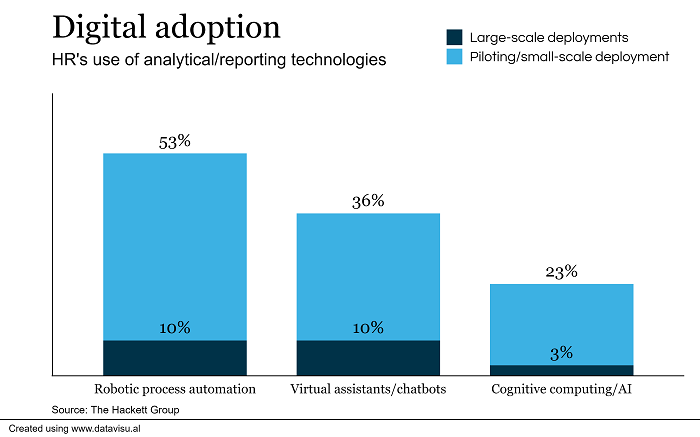As it does annually, The Hackett Group recently released a research report on critical issues HR leaders expect to face during the coming year. And, unsurprisingly, three of the main challenges identified specifically involve technology and how it interacts with the business climate driven by the ongoing COVID-19 pandemic.
The report, 2021 CHRO Agenda: 10 Key Issues HR Needs to Act on Now, is based on data gathered from more than 300 executives in finance, HR, IT, procurement, supply chain and global business services at mid-size and large enterprises worldwide.
These are three main areas HR is prioritizing in 2021:
A dramatic shift in enterprise priorities toward digital transformation: This year, enterprise digital transformation rose five spots to become the top-cited initiative in the report. To facilitate greater agility, HR organizations expect to grow their deployment of cloud-based HR suites and business process management tools by 20% and 17%, respectively. While HR organizations have piloted certain emerging technologies, broad adoption of some, including robotic process automation, virtual assistants/chatbots and cognitive computing, remains limited.
 “Digital transformation of the business has accelerated HR’s transformation of its service delivery,” says Tony DiRomualdo, senior research director at The Hackett Group. “We’ve seen areas like talent acquisition and learning and development go to 100% virtual almost overnight.”
“Digital transformation of the business has accelerated HR’s transformation of its service delivery,” says Tony DiRomualdo, senior research director at The Hackett Group. “We’ve seen areas like talent acquisition and learning and development go to 100% virtual almost overnight.”
Digital transformation within HR requires investment and time commitment, which is difficult with the pandemic still being a day-to-day concern, he adds.
This topic will be among the challenges addressed at the Spring HR Tech Conference, scheduled for March 16-19 at no cost to participants. In particular, keynoter Jason Averbook will look at ways organizations can take a “whole-person approach to digital transformation” during his March 18 session.
Spring HR Tech is coming. Register here.
Increased focus on improved analytics and modeling: According to the report, improving analytical, modeling and reporting capabilities is the issue that survey participants said HR struggles with most. Yet, implementing such tools and developing staff skills necessary to use them are critical to improving strategic decision-making, predictive insights and agility, respondent said. With that, survey participants projected an 18% growth in the adoption of advanced analytics tools in 2021 and a 15% growth in the use of data visualization tools.
“This is a persistent weakness for HR that the pandemic put in the spotlight,” DiRomualdo says. “We’re seeing an emerging focus on applying tools and tech around analytics and modeling to track things like workforce wellbeing and resilience, and also workforce engagement and productivity.”
He adds that there is an expanded emphasis on data monitoring in those areas, including exploring influences on wellbeing and resilience and understanding productivity and engagement drivers. With so many working from home, the context and importance of this have changed, DiRomualdo says.
Even higher WFH numbers within HR: Another expected tech-related challenge this year is ongoing remote work for HR professionals. According to the survey, just 4% of HR and general and administrative staff worked from home pre-COVID. Now, 25% are expected to work from home this year, and another 33% will have a hybrid arrangement.
“We’ve been at it for close to a year now,” DiRomualdo says. “While reports are that productivity has held up, and we’re getting better at using collaborative tools, there is still a lot of apprehension about burnout, loss of connection to colleagues and the impact of remote work on culture. This is an opportunity for HR to help create a ‘work-from-anywhere’ culture with technology, tools and practices.”
When organizations do start bringing some workers back to physical spaces, HR needs to take the lead on figuring out how to use that in-person time to help employees safely spend time with colleagues, broaden their network and work collaboratively.
“The office needs to be transformed purposefully,” he says, “not just used as a space where people rotate in waves to work at desks or cubicles. This requires explicit thinking.”
Other key focus areas for HR leaders in 2021 include:
- acting as a strategic advisor to the business
- creating and/or maintaining a high-performance culture
- aligning workforce strategy with business strategy
- improving HR agility
- enabling business strategy execution
- increasing workforce diversity, inclusion and belonging
- supporting cost-reduction strategies
See also: Learn from ‘those shaping the next generation’ of tech